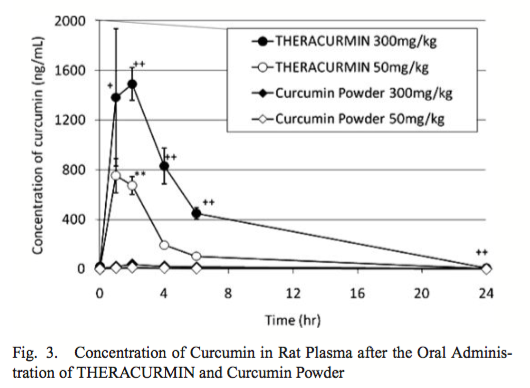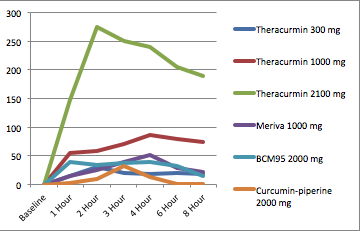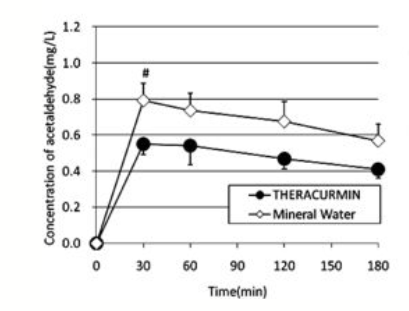It is also a great infection fighter, having antiviral, antibacterial and antifungal properties, helps the liver to detoxify and is remarkably non-toxic even at relatively high doses. It is really one of those miraculous compounds that affects so many critical health processes in an extremely positive way. For these reasons it is one of the most researched therapeutic herbs with almost 7,000 published studies.
There is, however, one issue – it doesn’t easily absorb from the gut into the blood. It is still worth including in your diet but for therapeutic uses you want a turmeric extract that has good bioavailability.
A number of biotech companies have succeeded in improving its absorption by attaching it to some kind of fatThere are many different types of fats; polyunsaturated, monounsaturated, hydrogenated, saturated and trans fat. The body requires good fats (polyunsaturated and monounsaturated) in order to… (lipidFats, oils, waxes and sterols are collectively known as lipids….). Two brands called Longvida and Meriva do this by attaching it to phospholipids. Another, Biocurmax (also known as BCM-95) use a curcumin oil.
But the latest curcumin form, with the most clinical research, is called Theracurmin creates super-small ‘colloidal’ particles of curcumin, about a hundred times smaller than the particle size of regular curcumin, that easily dissolve to deliver the goods across the gut into the bloodstream, and also across the blood-brain barrier. This is something you can easily see by putting a teaspoon of turmeric in a glass of water versus a teaspoon of Theracurmin – look at the glass on the right in the film below – this one contains the Theracurmin which just diffuses into the water, and does the same thing, diffusing across the gut into the bloodstream.
There is no question that this ‘delivery’ system does substantially increase the amount of curcumin, and its metabolites, that you get into the bloodstream.
For example, the graph below shows the comparison between Theracurmin and curcumin itself. Curcumin, at two doses, are the lines with diamonds on them that hardly register for increasing curcumin in the blood plasma.

However, is Theracurmin the most bio-available? Before looking at a comparison it is worth pointing out that these different supplements of curcumin are not 100% curcumin. For example, Longvida and Meriva are 80% phospholipids bound to 20% curcumin. So, if you were taking 1,000mg of Longvida you’d be getting 200mg of curcumin. Similarly, 10% of the Theracurmin is curcumin. So, 300mg of Theracurmin gives you 30mg of curcumin. So, in the above graph, 300mg of Theracurmin, giving 30mg of curcumin, is absorbed hundreds of times better than 50mg of curcumin powder.
The graph below shows a comparison of the different most bio-available forms of curcumin. As you can see Theracurmin is not only the one that most raises blood levels of curcumin but it also keeps those levels raised for at least 4, if not 8 hours. Also, the higher the dose, the greater the increase, with no drop off at 2,000mg dose. This means its method of delivery hasn’t hit a maximum threshold.

For this reason I prefer Theracurmin and recommend it for people struggling with inflammation. It absorbs several times better then its competitors at the same dose. For example, if you look at Theracurmin 1,000mg (actually 100mg of colloidal curcumin) it achieves a blood level, after 4 hours, of 86 ng/ml, compared to Meriva 1,000mg (actually 200mg of curcimun) which achieves a blood level of 51ng/ml.
After eight hours the effects are even more striking. Theracurmin blood levels remain high at 76ng/ml, while Meriva has dropped to 22. So, plasma levels are more than three times higher. Studies on another supplement called Longvida show that a 2,000mg dose still only achieves a maximum saturation of about 32.5ng/ml, compared to 2,100mg Theracurmin achieving a maximum plasma level of 275ng/ml.
If you look at the orange line – curcumin plus piperine, which is the active component in black pepper that helps absorption – the plasma level after 3 hours of 2,000mg is 32.5ng/ml compared to over 250ng/ml and, after 4 hours, is 12.5ng/ml compared to 240ng/ml. So we can say that Theracurmin is ten times more effective in raising plasma levels. In comparison to standard curcumin it is well over a hundred times better absorbed. These results were published in a study in 2015.
In the body curcumin often circulates as curcumin-o-glucoronide (COG), which is acted on by an enzyme called glucoronidase to liberate the curcumin. Around cancer and inflammation sites there’s a lot of glucoronidase activity to free up curcumin to act locally. A study last year looked specifically at the effect of Theracurmin on prostate and bladder cells. You can see the results for yourself in the Oncology Reports journal.
This is what you want for a therapeutic effect. Of course, exactly how much you need of different curcumin compounds, for example, to reduce joint pain, is something that will only be discovered in clinical trials. The first, using Theracurmin, was a randomised double-blind controlled trial – the gold standard – giving placebo or Theracurmin (180mg – three capsules) to 50 people with knee osteoarthritis. The Theracurmin, not the placebo, significantly lowered knee pain and use of painkiller medication. This was published in the Journal of Orthopedic Science.
One measurable effect of curcumin, again using Theracurmin, is its ability to detoxify alcohol. Much of the ‘hangover’ effect from drinking alcohol is due to the formation of acetaldehyde. In the experiment below people were given a measured amount of alcohol, after which they either drank mineral water or were given Thercurmin (300mg – 30mg of curcumin). The Theracurmin cut the level of acetaldehyde by about a third, compared to drinking mineral water. (I would recommend both.)

600mg of Theracurmin which is a very good daily level, is proven to be effective in several trials, for example, if you suffer from inflammation. For acute situations and more serious diseases there is a good case for using higher doses of 1,200 to 1,800mg.
If you’d like to dig deeper into natural anti-inflammatory foods read the March issue (coming soon) of my 100% Health Newsletter (subscribe here) and read Say No to Arthritis. Also visit HOLFORDirect.com home of GL friendly foods, supplements, books and tests.

Comments
Join the Conversation on our Facebook Page